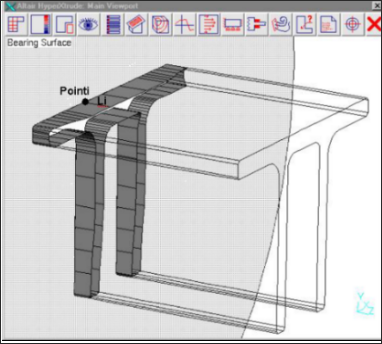Bearing Surface |

|

|

|

|
|
Bearing Surface |

|

|

|

|
BC_Type = Bearing: This boundary type is used to impose conditions at the bearing land area. This area represents the die surface last in contact with the extruded material. The accurate modeling of friction and heat generation occurring at this area is critical for a robust extrusion analysis. The syntax for this boundary condition is:
Bearing BearingSurf { Bearing_Profile = "Bearing_def"
FrictionModel = "SlipVelocity", "Coulomb" or "ViscoPlastic"
HeatFlux = q | ConvCoeff = hc, ConvTref = Tinf }
Here BearingSurf is the name of the Bearing boundary specified by you. Bearing_def is the name of the BearingProfile data packet that defines the profile of the die exit and the land area. This packet must be defined in the grf file prior to defining the Bearing BC; it has the following format:
BEGIN PROBLEMDATA
BearingProfile Bearing_def {
Point1 X1 Y1 Z1 L1 Slip_Coeff1 Slip_Velocity1
Point2 X2 Y2 Z2 L2 Slip_Coeff2 Slip_Velocity2
Point3 X3 Y3 Z3 L3 Slip_Coeff3 Slip_Velocity3
Point4 X4 Y4 Z4 L4 Slip_Coeff4 Slip_Velocity4
Point5 X5 Y5 Z5 L5 Slip_Coeff5 Slip_Velocity5
........
}
END
Variable Name |
Description |
Valid Data Types |
FrictionModel |
Friction model |
["SlipVelocity"]/"Coulomb" |
FrictionCoeff |
Friction coefficient |
CONSTANT |
HeatFlux (q) |
Magnitude of surface heat flux |
CONSTANT, EXPRESSION f(x,y,z,t) |
ConvCoeff |
Convective heat transfer coefficient |
CONSTANT, EXPRESSION f(x,y,z,t) |
ConvTref |
Outside temperature |
CONSTANT, EXPRESSION f(x,y,z,t) |

Non-Uniform Die Bearing Area
In the figure above, Pointi is the name given to a point i of the profile of the die exit. Xi, Yi, Zi are the coordinates of Pointi. Li is the length at Pointi of the bearing area in the extrusion direction. Slip_Coeff is the value of the Slip Coefficient between the die and the workpiece at Pointi, and SlipVelocityi is the Velocity value of the boundary (die bearing) in the slip direction. The profile surface farther than Li from the die exit is considered a free surface.
The friction at the tool-workpiece interface is computed using the specified friction model. The name of this model must be specified inside double quotes. Refer to the section on friction model to learn more about the supported friction models.